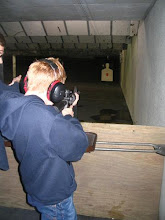Prospect avenue was lined with shabby apartments and small, forlorn houses. The paint on the buildings was chipping, fading and in places, decaying brown wood was visible. Dirt stained windows opened to blackness within. A few houses were fixed up, quaint little buildings with good strong wood, fresh paint or vinyl sidings, but these were the minority. Rumford from Prospect whimpered of disrepair and hard times. The rest of the town was more of the same, shabby apartments, clumsily built houses, dirt and neglect.
A car sat out of one run-down complex, a trash-laden building that had an enclosed front porch filled with useless and forgotten junk. The offensive car was old, a model from twenty to thirty years ago, painted a disgusting brown, and the paint was chipped, the rusty metal showed through in places, more pronounced in the various dents in the body. The windshield was dusty and dirty, a dull grey film obscured the view to old ripped pleather seats. The tires were deflated. The dead corpse of a car sat quiet and forgotten in front of this junk house.
Upon the car, was snow. Bordering the street, was more snow. Dirty snow, with bits of rocks and hair and salt piled high along the edges, higher than the cars parked in driveways, mountains of soggy filth. It was March, a season in New England that was especially dirty, and the beating rays of the sun could neither decide to melt or to freeze the little mill town, so it did both. This of course, made for wet, slushy streets, salted and covered in dirt by snowplows so cars could have traction, giving the snow mounds a sickly white color.
From Prospect, the town was quiet. The dull rumbling of vehicles on Route 2 created the only ambient noise. Occasionally a car or a pedestrian would come by, but Rumford was quiet, a dying town with little left to say.
Prospect intersected with Route 2 about a mile from home, at the top of a hill. There, another mile away, was the mill, the sole economic source of the town. A sulfurous paper mill which employeed 800 workers and gave the town a reason to exist. The townsfolk were us to it, the stench no longer registered in their noses, but foreigners, which to the townsfolk was a label applied to anyone who lived in Auburn or beyond, could smell it. It was a repugnant stench, and if a townsperson could smell it, it spoke of low pressure and coming rains. Otherwise, the ghastly sulfur smell was ignored.
On an island across from a arched bridge, with it's green paint peeling, was a collection of red brick buildings. This was the business district. It had three streets, a two lane, one way street down the center and two flanking streets on the other side. It played host to a few businesses, some permanent, but most only lived for about a year before they were unable to operate any longer. Only two chains were found down there, a Rite Aid, and a Dunkin' Donuts.
Atop the hill from the green-arched Morse Bridge (the bridge to downtown) was a Catholic Church, it's splendorous spires hidden away in scaffolding. And still, the houses on the road were shabby, old Victorian homes with peeling paint and dirty windows. But past the church, it got somewhat better. Little houses with fresh paint looked respectable on the road, showing some sign that Rumford, while dying, wasn't dead yet. And then, there was the hospital at the top of the hill.
And what a sight it is. The building was built of red brick with stairs going up to an entrance adorned with greek columns and a greek overhang. But above the alcove where the ambulances dropped of their patients, was an enormous modern overhang of windows, as if some alien saucer had smashed into the rectangular building, creating an eyesore of a combination of new and old styles.
From the hospital, one could look down a precipitous road that dropped steeply for a very long ways. Looking yonder, one could see the snow buried sports fields far beyond the supermarket and the elementary school. The traffic went from dead to busy as Route 2 intersected Lincoln at the only busy light in town (but not the only light).
I could go on with my tour of my home town, but it really is more of the same.
Subscribe to:
Post Comments (Atom)

No comments:
Post a Comment